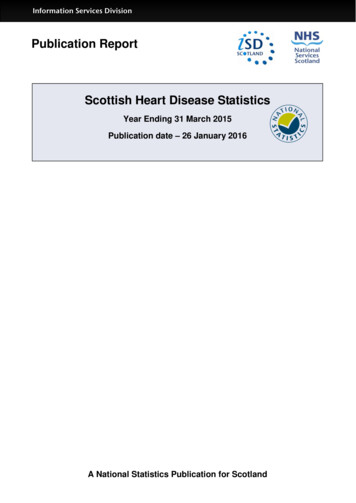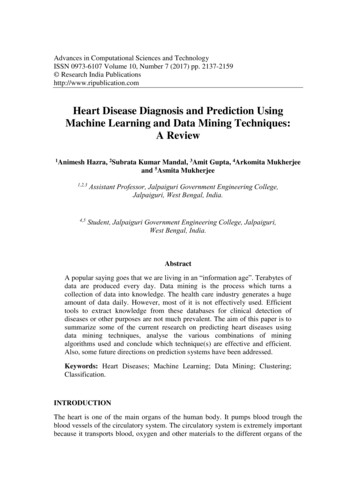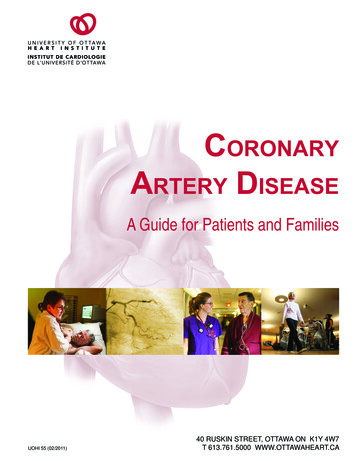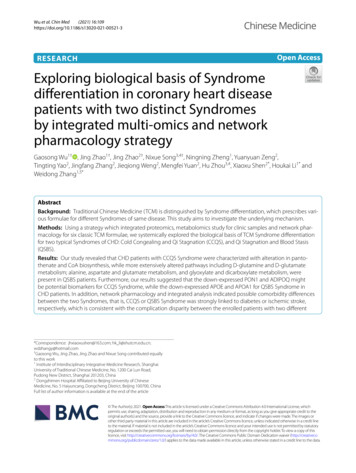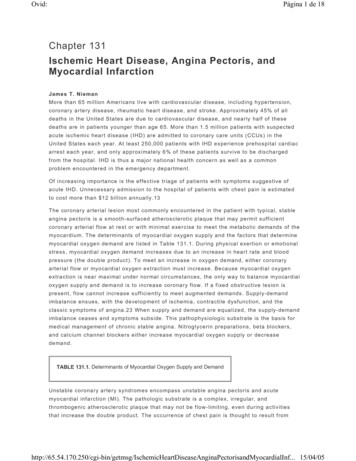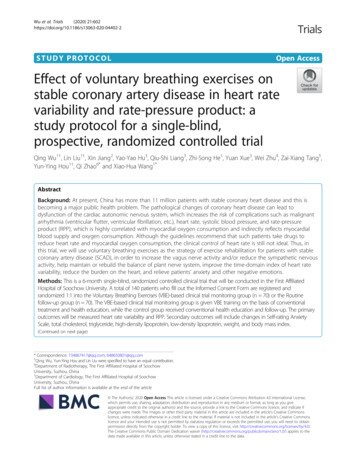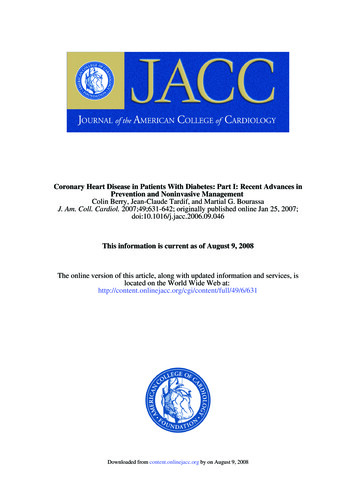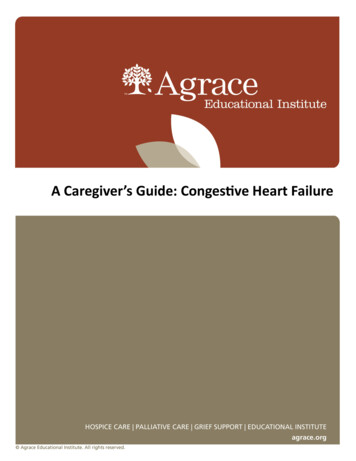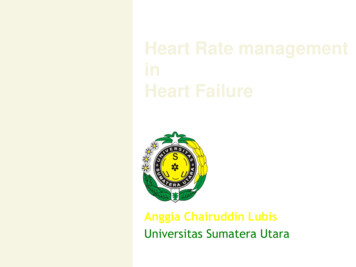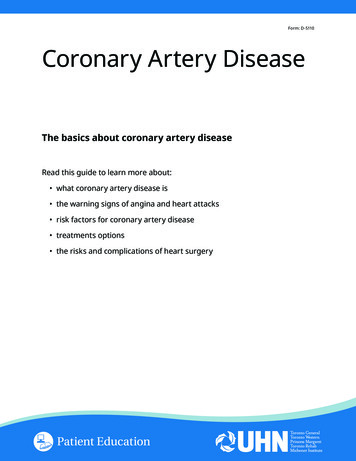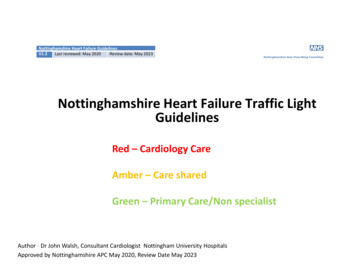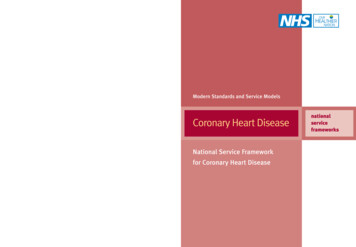
Transcription
Modern Standards and Service ModelsCoronary Heart DiseaseNational Service Frameworkfor Coronary Heart Disease Crown CopyrightProduced by Department of Health16602 1P 30k Mar 2000 (SWI)CHLORINE FREE PAPERnationalserviceframeworks
National ServiceFramework forCoronary Heart Diseasecontents12pageForeword by the Secretary of State2Standards table4The National Service Framework forCoronary Heart Disease5National standards and service models16Standards one and twoReducing heart disease in the population17Standards three and fourPreventing CHD in high risk patients23Standards five, six and sevenHeart attack and other acute coronary syndromes27Standard eightStable angina34Standards nine and tenRevascularisation39Standard elevenHeart failure46Standard twelveCardiac rehabilitation523Local delivery614Ensuring progress73contents5National support for local action83AppendicesPage cov2March2000A Membership of the External Reference Group112B Abbreviations115C Glossary117D Examples from NHS Beacons123
sNational Service Framework forCoronary Heart DiseaseModern Standards & Service Models
National Service Framework – Coronary Heart DiseaseForeword by the Secretary of StateThe Government is committed to building a new NHS: faster, fairer and moreconvenient for patients; a health service fit to face the challenges of the newMillennium. Ours is a radical and far reaching programme to transform the NHS.It will remain true to its values – based on need and not the ability to pay – butthe changes we are making will make the NHS of old unrecognisable by the timewe have finished our ten year programme of modernisation.For far too long it was accepted that NHS treatment and care would be better insome parts of the country than in others – not any more. We are determined tomake sure that, in future, people in every part of our country can get the topquality and treatment and care they need, whether from their local doctors orcommunity services, local district general hospitals or specialist regional centres.National Service Frameworks set out plans, based on the evidence of what worksbest, to ensure that in future these standards of care are available to everyone.Coronary heart disease is among the biggest killers in this country. More than1.4 million suffer from angina. 300,000 have heart attacks every year. More than110,000 die of heart problems in England every year. But the effects of heartdisease are unequal: among unskilled men the death rate is almost three timeshigher than it is among professionals. These differences have more than doubledin the past twenty years. Heart disease is much more common in deprived areas,yet treatment and care is often better in more prosperous areas. This “postcode”lottery of care is unacceptable and we are determined to end it.This National Service Framework for Coronary Heart Disease is our blueprint fortackling heart disease. It has been prepared by an independent expert group ledby Professor Sir George Alberti, President of the Royal College of Physicians. Itsets out the standards and services which should be available throughoutEngland. It recognises the importance of modern prevention and primary care aswell as the contribution of the more specialised services. It describes wideranging action to help people avoid getting heart disease. It then sets out thehigh quality treatment and care which those people who do become ill shouldhave: early diagnosis, prompt and effective ambulance and emergency services,high quality medical, surgical and nursing care, specialist services including heartsurgery and rehabilitation to help those people who have had a heart attack orheart operation to recover more quickly and to stay well.Page 2
Foreword by the Secretary of StateThis is part of our aim to enable everyone to enjoy better health. We have alreadyset out in the White Paper Saving Lives: Our Healthier Nation our commitment toreducing the death rate from heart disease and related illnesses such as stroke inthose aged under 75 by two-fifths by 2010. We have already taken action acrossGovernment to combat some of the root causes of ill health, causes like povertywhich we are fighting through the New Deal to help people get jobs and theNational Minimum Wage to end low pay. We have provided help for people whowant to stop smoking and we are determined to ban tobacco advertising.No one should doubt the Government’s determination to tackle heart disease.In common with many others, those parts of the NHS dealing with heart diseasehave suffered from decades of neglect. The programme we have set out ischallenging and won’t be achieved overnight. We know that it will need moredoctors and nurses and that training these key professionals takes time. But weare committed to a ten year action plan to modernise and to bring the wholeservice up to the standards of the best – people will see a real difference.And we have identified immediate priorities for action in this NSF that will beginto make a real difference from the start.This Framework will transform the prevention, diagnosis and treatment ofcoronary heart disease. It will help professionals to give better, fairer and fastercare everywhere, to everyone who needs it. We want a service that is the best inthe world. Our people deserve nothing less.Alan MilburnSecretary of State for HealthPage 3
National Service Framework – Coronary Heart DiseaseStandards tableStandards 1 & 2:1. The NHS and partner agencies shoulddevelop, implement and monitor policies that reduce the prevalence ofcoronary risk factors in the population, and reduce inequalities in risks ofdeveloping heart disease.Reducing heart diseasein the populationStandards 3 & 4:2. The NHS and partner agencies shouldcontribute to a reduction in the prevalence of smoking in the local population.3. General practitioners and primary care teams shouldidentify all people with established cardiovascular disease and offer themcomprehensive advice and appropriate treatment to reduce their risks.Preventing CHD in highrisk patients4. General practitioners and primary health care teams shouldidentify all people at significant risk of cardiovascular disease but who havenot developed symptoms and offer them appropriate advice and treatment toreduce their risks.5. People with symptoms of a possible heart attack shouldreceive help from an individual equipped with and appropriately trained in theuse of a defibrillator within 8 minutes of calling for help, to maximise thebenefits of resuscitation should it be necessary.Standards 5,6 & 7: Heartattack and other acutecoronary syndromes6. People thought to be suffering from a heart attack shouldbe assessed professionally and, if indicated, receive aspirin. Thrombolysisshould be given within 60 minutes of calling for professional help.7. NHS Trusts shouldput in place agreed protocols/systems of care so that people admitted tohospital with proven heart attack are appropriately assessed and offeredtreatments of proven clinical and cost effectiveness to reduce their risk ofdisability and death.Standard 8: Stable anginaStandards 9 & 10:RevascularisationStandard 11:Heart failureStandard 12:Cardiac rehabilitationPage 48. People with symptoms of angina or suspected angina shouldreceive appropriate investigation and treatment to relieve their pain and reducetheir risk of coronary events.9. People with angina that is increasing in frequency or severity shouldbe referred to a cardiologist urgently or, for those at greatest risk, as anemergency.10. NHS Trusts shouldput in place hospital-wide systems of care so that patients with suspected orconfirmed coronary heart disease receive timely and appropriate investigationand treatment to relieve their symptoms and reduce their risk of subsequentcoronary events.11. Doctors shouldarrange for people with suspected heart failure to be offered appropriateinvestigations (eg electrocardiography, echocardiography) that will confirmor refute the diagnosis. For those in whom heart failure is confirmed, its causeshould be identified – treatments most likely to both relieve their symptomsand reduce their risk of death should be offered.12. NHS Trusts shouldput in place agreed protocols/systems of care so that, prior to leaving hospital,people admitted to hospital suffering from coronary heart disease have beeninvited to participate in a multidisciplinary programme of secondary preventionand cardiac rehabilitation. The aim of the programme will be to reduce theirrisk of subsequent cardiac problems and to promote their return to a full andnormal life.
Section 1: National Service Framework for Coronary Heart Disease1.0National Service Framework for Coronary Heart Disease developing the National Service Framework for coronary heart disease a new vision for coronary heart disease a Government-wide agenda effective services available to all who can benefitIntroduction1.1The new NHS 1 announced the Government’s intention to modernise the NHS. It set out anumber of important principles and a range of measures to improve the quality of careand reduce unacceptable variations. Services should be accessible on the basis of needirrespective of age, gender, race, culture, religion, disability, sexual orientation or wherepeople happen to live, and be responsive to individuals’ needs. Modernising SocialServices 2 similarly included proposals for ensuring the delivery of high quality personalsocial services.1.2The Government is committed to modernising all aspects of care and treatment. But thepriority is to deal with the biggest killers, including CHD and stroke. This will help tackleinequalities as the burden of these diseases falls heavily on the most disadvantaged.Effort needs to be focused on making services faster, stepping up prevention work andimproving primary and community as well as acute services. This is outlined in theNational Priorities Guidance 2000/01-2002/03 (HSC 1999/242, LAC (99)38).1.3A First Class Service 3 explained how standards would be set, delivered and monitored(see Figure 1). Clear quality standards will be: set by the National Institute for Clinical Excellence (NICE) and National ServiceFrameworks (NSFs) delivered by means of clinical governance, underpinned by professional selfregulation and lifelong learning monitored by the Commission for Health Improvement (CHI), the NHS PerformanceAssessment Framework and the National Survey of NHS Patients.1.4These elements together form the quality framework (Figure 1)Page 5
National Service Framework – Coronary Heart DiseaseNational Service FrameworksNational Institute for Clinical Excellence Fig. 1 Quality Framework from A First Class ServiceClear standards of serviceProf. self regulationClinical GovernanceLifelong learning Patientand publicinvolvementDependablelocaldelivery Commission for Health Improvement NHS Performance Assessment FrameworkMonitored standardsNational Survey of NHS Patients1.5Other parts of the modernisation programme include improving the NHS ITinfrastructure, Information for Health 4, and the NHS human resources strategy on staffingand training,Working Together 5.1.6The first two National Service Frameworks (NSFs) extend the modernisation programmefor the first time into specific patient services. They build on the work already done oncancer services following the Calman-Hine Report6 and on paediatric intensive care. Arolling programme of work to develop NSFs was set out in HSC 98/074 (National ServiceFrameworks)7. The next will be for older people to be published in 2000, followed by anNSF for diabetes in 2001.1.7For these first NSFs, two of the most significant causes of ill health and disability inEngland have been selected – coronary heart disease (CHD) and mental health. Both arepriorities in Saving Lives: Our Healthier Nation 8. This NSF will contribute to progresstowards the targets in Saving Lives: Our Healthier Nation and shares the goals ofreducing the incidence of illness and death caused by CHD and reducing undesirablevariations in access to services and in quality of care.1.8CHD is the single commonest cause of premature death in the UK. It is a condition thatmakes a significant impact on every aspect of an individual’s life including their qualityof life, future employment and personal relationships, as well as increasing the risk oftheir dying early. Much can be done to reduce the suffering caused by CHD and to stopit developing in the first place. The Government sees this as a major priority.Page 6
Section 1: National Service Framework for Coronary Heart Disease1.9The burden of CHD is not distributed equally in society. The death rate among men frommanual classes is 40% higher than for non-manual workers. Men of working age in socialclass V are 50% more likely to die from CHD than men in the population as a whole. Thewives of manual workers have nearly twice the risk compared to wives of non-manualworkers. This social class gradient is also reflected in morbidity rates, with angina, heartattack and stoke all more common amongst those in manual social classes.1.10There are also ethnic variations. For people born in the Indian sub-continent, the death ratefrom heart disease is 38% higher for men and 43% higher for women than rates for thecountry as a whole.1.11Death rates are higher for people living in the north of the country. The death rate fromheart disease in people under 65 is almost three times higher in Manchester than inKingston and Richmond.1.12Inequalities between rich and poor have increased over the last 20 years; CHD death rateshave declined faster among the more affluent in society than among those who are less welloff. Evidence indicates that much more can be done to prevent and reduce the sufferingcaused by CHD.1.13The evidence shows that: rates of CHD vary according to social circumstances, gender and ethnicity differences across the social spectrum have been growing many people are not receiving or acting on advice and help that could stop themdeveloping CHD in the first place many people with CHD are not receiving treatments of proven effectiveness there are unjustifiable variations in quality and access to some CHD services.1.14There is also evidence that timely effective treatment can reduce suffering and the risk ofdeath from CHD and that a more systematic approach to the delivery of care can ensurethat all those likely to benefit do gain access to appropriate services. However, staffworking in the NHS need better ways of identifying people who need services and ofmonitoring the delivery of those services to ensure that the anticipated outcomesare delivered.1.15The aim of NSFs is to: specify interventions that are known to be effective identify, where possible, models of care that deliver those interventions reliably provide the means to implement improved systems of care develop audit tools and performance indicators to help ensure services are beingdelivered to an acceptable standard indicate milestones and goals by which the NHS can monitor progress towards deliveryPage 7
National Service Framework – Coronary Heart Disease identify gaps in knowledge or standards to inform the research and other agendas institute a system for reviewing and updating the contents of the NSF in line withmedical developments.1.16The effect of the NSF will be to reduce undesirable variations and inconsistencies inservice delivery and access, improve overall quality of care for CHD and therebyimprove the overall health of the population (contributing to the achievement of targetsset out in Saving Lives: Our Healthier Nation). Not only will the NSF reduce the burdenof CHD, but it will also have benefits for patients with stroke and other diseases.Guiding values and principles1.17In drawing up the NSF there are a number of fundamental values and guiding principleswhich provide the foundation for developing national policies for CHD. It is these thatunderpin the drive to promote health and reduce inequalities, raise the quality of clinicalcare, and reduce variations in access to, and the quality of, services. Quality: Members of the public, wherever they live, rightly expect to receive high-qualityservices, delivered when they need them, to a high technical standard and compassionatelyby well-trained, competent staff, regardless of gender, disability, ethnicity and age. Quality ofcare depends not only on the quality of interaction between the clinician and the patient,but also on the quality of the organisation and the environment in which this takes place. Information: Consistent, accurate and clear information should be readily available formembers of the public about how they can play their part in preventing and managingCHD. Health professionals and others should be actively involved in educatingmembers of the public, and should be supported in communicating information aboutrisks and how to reduce them. Patients should expect, at every stage of their care, tobe treated with respect and sensitivity. They should be provided with accurate, relevantand clear information, so that they and their families can understand the illness and itstreatment and be as involved as they wish in the planning of their care. Health impact: The Government’s actions influence the wider determinants of healthwhich include the distribution of wealth and income. A wide range of its policies willhave an impact on CHD including social and legal policies and policies on transport,housing, employment, agriculture and food, environment and crime. Health impactassessments will be used when new policies are under consideration to determine thelikely effects on the health of the population. Public health programmes: Health and local authorities should lead the developmentand implementation of effective public health programmes to ensure that targets set inSaving Lives: Our Healthier Nation for circulatory disease are met and that healthinequalities associated with CHD are reduced. CHD prevention and treatment policieswill be determined and agreed following consultation among the key agencies,including the NHS, local and national government, the voluntary sector and the publicthemselves. Every Health Authority (HA) will have a local CHD implementation teamand every NHS Trust and Primary Care Group/Primary Care Trust (PCG/PCT) will beexpected to appoint a CHD lead.Page 8
Section 1: National Service Framework for Coronary Heart Disease Inequalities: CHD policies should aim to reduce inequalities in health. Resources willbe targeted at those in greatest need and with the greatest potential to benefit. Evidence-based: CHD policies are to be based on the best available evidence;wherever possible, these will be well-conducted, updated systematic reviews of valid,relevant evidence. Policies will evolve to incorporate the conclusions of importantnew research as it becomes available. The research base will include the causes andmechanisms of CHD, evidence on clinical and cost-effectiveness of interventions,health impact assessments of major Government policies and the monitoring of theeffects of the CHD NSF. Information about the effectiveness and cost-effectiveness ofinterventions, the CHD needs of the population and the performance of services willbe shared openly with the public. NHS and Department of Health Research andDevelopment programmes will embrace CHD as one of their highest priorities. Integrated approach: The prevention and treatment of CHD will be tackled in everyaspect of health policy, health promotion, primary care, community care and hospitalcare. There will be effective communication and collaboration between the differentagencies and their staff. The initial aim will be to improve the health of, and servicesfor, people and communities with the greatest disease burden, and to raise qualitywhere services are demonstrably weak. Ethics and standards of professional practice: The NHS will expect that its staff adoptprofessional codes of ethics and standards of professional practice such as those inthe General Medical Council’s publication Good Medical Practice, and the Code ofProfessional Conduct published by the United Kingdom Central Council for Nursing,Midwifery and Health Visiting. Volunteers: Voluntary organisations and carers at home and in the community have amajor role in tackling the causes of CHD, in supporting people who are sufferingfrom CHD – including those in need of palliative care – and in providing emergencycare for people suffering heart attacks in public places.1.18Four important principles underpin this NSF: firstly, reducing the burden of CHD is not just the responsibility of the NHS. It requiresaction right across society secondly, the quality of care depends on:- ready access to appropriate services- the calibre of the interaction between individual patients and individual clinicians- the quality of the organisation and environment in which care takes place thirdly, excellence requires that important, simple things are done right all the time fourthly, delivering care in a more structured and systematic way will substantiallyimprove the quality of care and reduce undesirable variations in its provision.Page 9
National Service Framework – Coronary Heart DiseaseDeveloping the National Service Framework1.19This NSF on CHD has been developed with the assistance of an expert External ReferenceGroup (ERG). The ERG was co-chaired by Professor Sir George Alberti, President of theRoyal College of Physicians, and Dr Graham Winyard (until December 1998) and DrSheila Adam (from January 1999), Deputy Chief Medical Officers in the Department ofHealth. The ERG brought together health and social care professionals, service users andcarers, health service managers, partner agencies, and other advocates. A full range ofviews was sought by the ERG, which was assisted by the Department of Health.1.20The ERG agreed early on that the NSF should cover the whole spectrum of CHD fromprimary prevention through primary, emergency and secondary care to rehabilitation. TheERG also agreed that it had to set formal standards in each area of care which the NHSwould be expected to achieve. Those standards of care had to be based on clear evidencethat the interventions required to achieve the standards are both clinically and costeffective. The ERG set up a number of focus groups to review the evidence in each area.1.21Emerging findings of the ERG were published in November 1998 under cover of HSC98/218/LAC 98/29 (National Service Framework for Coronary Heart Disease).9 Theseoutlined the initial action which health and local authorities working with their partnersneed to undertake jointly to start to plan local implementation of the standards throughtheir local Health Improvement Programmes (HImPs).1.22The ERG went on to decide that setting standards alone was not enough. Those working inthe NHS and Social Services needed more than information about what was of proveneffectiveness. They would need advice about the best means of delivering those interventionsreliably. This meant wherever possible identifying models of care or systems of servicedelivery which had been shown to be effective. Some would need additional resources toachieve the standards, others would need additional training. New IT systems developed inconjunction with the NHS Information for Health strategy could make a major contribution toboth service delivery and monitoring. Furthermore, people needed to know when they hadachieved the desired level of service and whether it was delivering the expected benefits.This would require new audit tools and performance indicators.1.23The ERG recognised two further important principles: Such a programme of change cannot be achieved overnight. Overall the programmecould take 10 or more years to achieve. There had to be a set of milestones formeasuring progress against the standards and scope for modifying those milestones ifcircumstances changed. Even though CHD had been the focus of a very great deal of research, there weregaps in the knowledge base. The effectiveness of some treatments had not been fullyevaluated. New treatments would come on stream and further clinical guidance wouldbe required.Page 10
Section 1: National Service Framework for Coronary Heart Disease1.24There would need to be a system for monitoring the implementation of the NSF and forpromulgating new findings and for modifying systems of care, milestones, performancecriteria in line with new evidence.1.25Gaps in knowledge and clinical guidelines identified during the development of the NSFhave been used to develop the future programmes for research bodies and for NICE andother bodies responsible for producing clinical guidance.1.26Other Government policies of direct relevance to the NSF which have been taken intoaccount in the standards and service models include: Smoking Kills 10 Saving Lives: Our Healthier Nation 8 Report of the Independent Inquiry into Inequalities in Health (Acheson Report)11 A New Deal for Transport: Better for Everyone 12 Social exclusion initiatives Health Action Zones and Healthy Living Centres1.27The ERG felt that implementing the NSF would also go a long way to helping NHS staffto deliver other important parts of the modernisation programme, in particular the needfor audit and clinical governance. The programme would facilitate lifelong learning andrevalidation of clinical staff.Scope1.28This NSF is a practical, evidence-based and flexible approach to tackling CHD which: sets national standards (clinical and organisational) for preventing and treating CHD defines service models for preventing and treating CHD establishes initial milestones, goals and performance indicators against which progresswithin agreed timescales will be measured identifies practical tools to support implementation.1.29For the NSF to be successful, a wide range of people in many different agencies will haveto play their part in promoting continuous quality improvement in services throughout thecountry. It will involve people working in social services, public health specialists, primarycare teams, and hospital staff. Voluntary agencies, local authorities, education authorities,HAs, PCGs/PCTs and NHS Trusts will all contribute. The NSF is intended to bring togetherall those involved in any area who could influence CHD to work together to introducesystems that enable high quality services to be delivered by all.Page 11
National Service Framework – Coronary Heart DiseaseNational standards and service models1.30This NSF sets out twelve service standards that cover the following areas: Reducing heart disease in the population Preventing CHD in high-risk patients Heart attack and other acute coronary syndromes Stable angina Revascularisation Heart failure Cardiac rehabilitation.1.31In defining which standards and interventions are important for the NSF, and decidingon the rationale for each one, each has been considered against the following criteria: strength of evidence impact on individuals and the population cost-effectiveness and affordability robustness of monitoring arrangements practicality of implementation extent of significant variations in current practice.1.32Service models are described for all of these areas. There are many different existingservice models for CHD, though to date little robust evidence of the relative clinical andcost-effectiveness of these. Different models will apply in different settings takingaccount of prevalence and geography. Some arrangements appear to work better and tomake intuitive sense. The NSF draws upon examples of good practice which could beapplied more widely throughout the service.1.33The twelve national service standards are summarised in the table at the front of thisbook on page 4 and are described in Section 2. The evidence base for each of thestandards, the rationale for their selection, and the service and organisational modelsrequired to deliver them are set out in greater detail in the clinical chapters.1.34To help the NHS and its partners locally to plan and implement this ambitious programmeof change, the NSF identifies some immediate priorities. Initial milestones for eachstandard have been identified to help mark progress along the way towards goals resultingin improved services and better health. Further milestones will be set as change is rolledout. These will be more challenging for some parts of the NHS than others and it is notintended that every organisation will reach each milestone at the same time. It isparticularly important that time is allowed in some areas to allow an all-inclusive approachfor meeting the diverse needs of local communities, particularly hard to reach or high riskgroups, e.g. the elderly, people from ethnic minorities, and people with diabetes mellitus.Page 12
Section 1: National Service Framework for Coronary Heart Disease1.35Clinical audit criteria are identified to enable staff to monitor the effectiveness of theservices they deliver. Not all of these can be implemented immediately. The moresophisticated audits, particularly national systems, will need further development. Someperformance indicators will be included in the NHS Performance Assessment Framework.Systematic service reviews will be undertaken by the Commission for Health Improvementworking with the Audit Commission as appropriate (see Section 4). The National Survey ofNHS Patients will also provide valuable information about patients’ experiences.1.36In Section 5 a number of practical tools that are already available to help withimplementation are described. Others have been commissioned, and more will becommissioned, in a number of interlinked key areas essential to the delivery of the NSF.The five underpinning national programmes which will assist with this are: finance: revenue and capital human resources, workforce planning, education and training rese
in the past twenty years. Heart disease is much more common in deprived areas, yet treatment and care is often better in more prosperous areas. This "postcode" lottery of care is unacceptable and we are determined to end it. This National Service Framework for Coronary Heart Disease is our blueprint for tackling heart disease.
